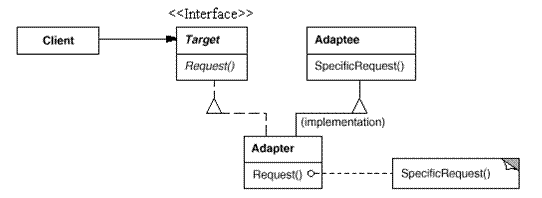java之适配器模式
来源:互联网 发布:c 经典书籍 知乎 编辑:程序博客网 时间:2024/04/30 09:01
适用情况:
以下情况使用适配器模式
• 你想使用一个已经存在的类,而它的接口不符合你的需求。
• 你想创建一个可以复用的类,该类可以与其他不相关的类或不可预见的类(即那些接口可能不一定兼容的类)协同工作。
• (仅适用于对象Adapter)你想使用一些已经存在的子类,但是不可能对每一个都进行子类化以匹配它们的接口。对象适配器可以适配它的父类接口。
其实现方式主要有两种:
类适配器
对象适配器

其中:
• Target
— 定义Client使用的与特定领域相关的接口。
• Client
— 与符合Target接口的对象协同。
• Adaptee
— 定义一个已经存在的接口,这个接口需要适配。
• Adapter
— 对Adaptee的接口与Target接口进行适配
package com.zhang.adapt.example3;
public interface ITarget {
int get110V();
}
package com.zhang.adapt.example3;
public class Adapter implements ITarget {
private Power power;
public Adapter() {
this.power = new Power();
}
@Override
public int get110V() {
power.get220V();
//业务逻辑
// TODO Auto-generated method stub
return 0;
}
/**
* @param args
*/
public static void main(String[] args) {
// TODO Auto-generated method stub
}
}
package com.zhang.adapt.example3;
public class Power {
public void get220V(){
//业务逻辑
}
}
- Java 之适配器模式
- java之适配器模式
- java模式之适配器模式
- Java模式之适配器模式
- java模式之适配器模式
- java适配器模式之--类适配器
- java适配器模式之二 --类适配器
- Java基础之适配器模式
- java GUI 之 适配器模式
- JAVA设计模式之适配器
- Java复习之适配器模式
- 深入浅出Java设计模式之适配器模式
- 深入浅出Java设计模式之适配器模式
- Java设计模式之适配器模式
- 深入浅出Java设计模式之适配器模式
- Java设计模式之适配器模式
- java 设计模式之七-适配器模式
- java设计模式之适配器模式
- php中heredoc的使用方法
- quartz使用cron表达式的实例
- 蓝牙的SDP协议总结
- mysql中bigint和datetime互转,并通过navicat实现批量修改。
- 获取应用程序所有安装包信息
- java之适配器模式
- 修数字手表
- java的几种对象(PO,VO,DAO,BO,POJO)解释
- Extjs form表单 动态设置标签的隐藏和显示 (解决问题)
- ios文件和文件夹管理
- android.content.res.Resources$NotFoundException: String resource ID #0x1
- windbg 调试驱动设置断点
- GNS3桥接物理网卡不通解决方法
- jquery操作td的方法


